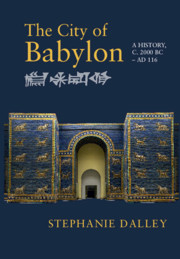Book contents
- The City of Babylon
- The City of Babylon
- Copyright page
- Contents
- Illustrations and Maps
- Preface
- Conventions
- Timeline
- Written Languages and Their Scripts
- 1 Land and Peoples
- 2 Discoveries and Excavations
- 3 First Kings to the End of the Great Rebellion, c. 1894–c. 1732
- 4 Law, Education, Literature, and the Path to Supremacy
- 5 From the Great Rebellion to the End of the First Dynasty, c. 1732–1592
- 6 The Next Six Centuries
- 7 In the Shadow of Assyria, 978–625
- 8 Empire
- 9 From the Death of Nebuchadnezzar II to the Death of Cambyses, 561–522
- 10 Darius I to Alexander, and Seleucid to Parthian Rule
- 11 First Parthian Conquest, 141 BC, to the Visit of Trajan in AD 116
- Appendix: Genesis 14:1–16 and Possible Links with Foreign Rulers Early in the Reign of Hammurabi
- Bibliography
- Index
8 - Empire
Nabopolassar and Nebuchadnezzar II, 625–5621
Published online by Cambridge University Press: 23 June 2021
- The City of Babylon
- The City of Babylon
- Copyright page
- Contents
- Illustrations and Maps
- Preface
- Conventions
- Timeline
- Written Languages and Their Scripts
- 1 Land and Peoples
- 2 Discoveries and Excavations
- 3 First Kings to the End of the Great Rebellion, c. 1894–c. 1732
- 4 Law, Education, Literature, and the Path to Supremacy
- 5 From the Great Rebellion to the End of the First Dynasty, c. 1732–1592
- 6 The Next Six Centuries
- 7 In the Shadow of Assyria, 978–625
- 8 Empire
- 9 From the Death of Nebuchadnezzar II to the Death of Cambyses, 561–522
- 10 Darius I to Alexander, and Seleucid to Parthian Rule
- 11 First Parthian Conquest, 141 BC, to the Visit of Trajan in AD 116
- Appendix: Genesis 14:1–16 and Possible Links with Foreign Rulers Early in the Reign of Hammurabi
- Bibliography
- Index
Summary
Nabopolassar fought with an Assyrian-style army and took the throne of Babylon. Thirteen years later, Nineveh fell despite Egyptian help. Babylon took over much of the Assyrian empire. Later he defeated the last Assyrian king at Harran. His success was seen as Marduk’s revenge. Captured wealth from Assyrian royal cities allowed major building work at Babylon, which was continued by Nabopolassar’s son Nebuchadnezzar II. Neither king left statues of themselves, and cylinder seals represent gods by their symbols. Major subsidence in the citadel required frequent rebuilding on the Southern Palace. The names of temples and gates were compiled on to a clay tablet as a literary work. Colour-glazed bricks adorned the Processional Way leading to the temple of the New Year festival outside the citadel walls. That festival is described. Some of his creations Nebuchadnezzar described as a Wonder, but he made no mention of the Hanging Garden. In a separate part of the citadel, Nebuchadnezzar built a Summer Palace. His conquests included Tyre and Ashkelon but not Egypt or Lydia. He sacked the Temple in Jerusalem and deported its royal family to Babylon. Other captives settled on land nearby. Business archives of long duration continue into the Achaemenid period.
Keywords
- Type
- Chapter
- Information
- The City of BabylonA History, c. 2000 BC – AD 116, pp. 214 - 247Publisher: Cambridge University PressPrint publication year: 2021

